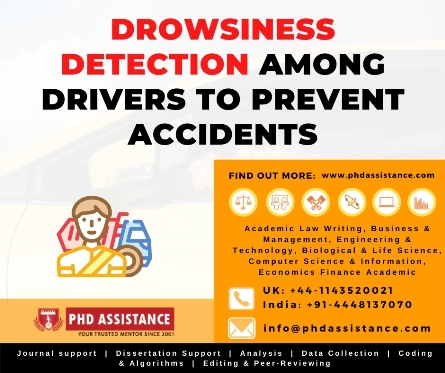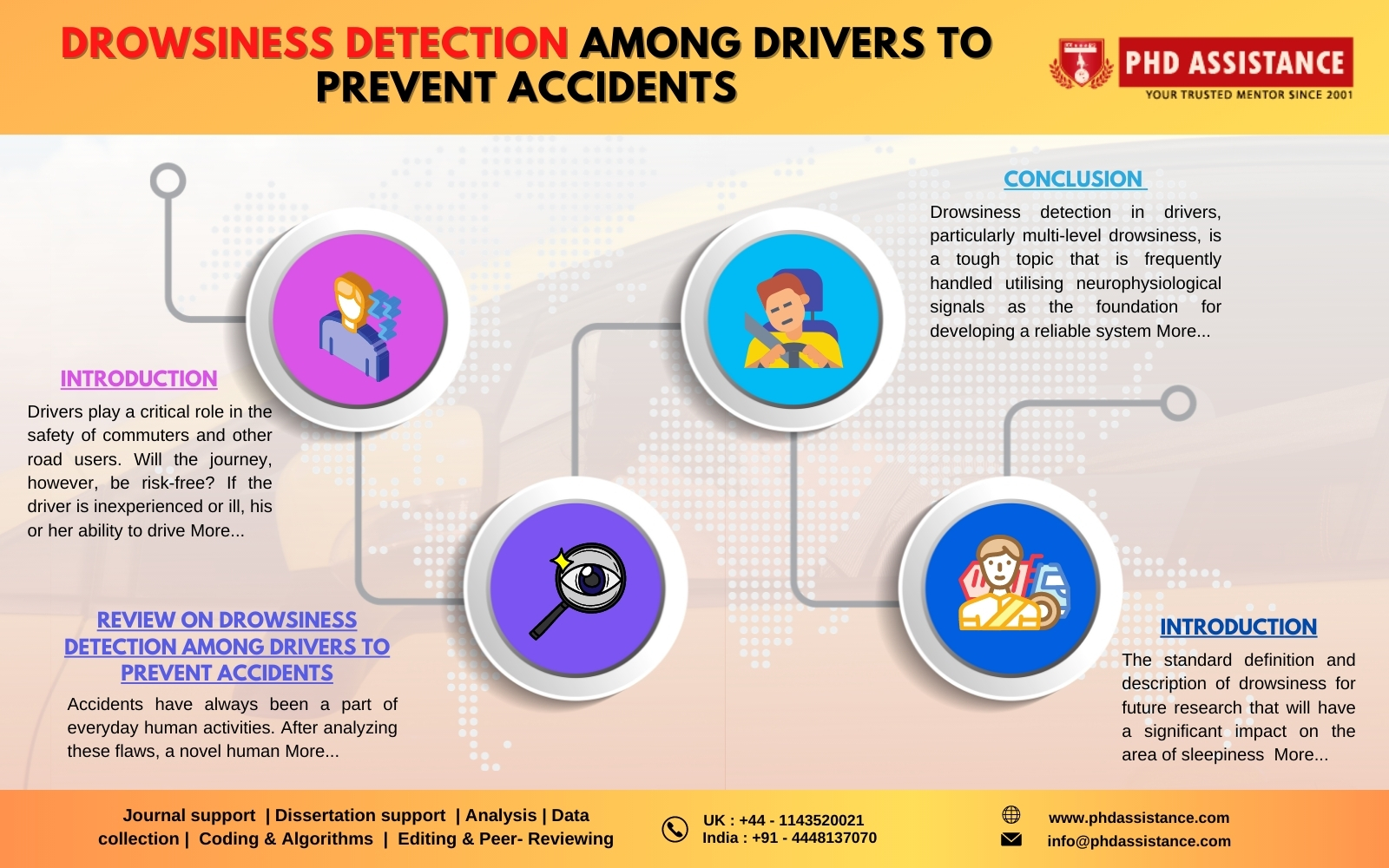Drowsiness Detection among Drivers to Prevent Accidents
Introduction
Drivers play a critical role in the safety of commuters and other road users. Will the journey, however, be risk-free? If the driver is inexperienced or ill, his or her ability to drive safely is severely limited. Furthermore, drowsiness and distractions cause drivers travelling late at night to fall asleep. These circumstances can lead to accidents or, in the worst-case scenario, death (Bakheet & Al-Hamadi, 2021). To address these issues, self-driving assistant systems must be capable of detecting the driver’s level of inattention and alerting them with a warning signal.

Review on Drowsiness detection among drivers to prevent accidents
Accidents have always been a part of everyday human activities. After analyzing these flaws, a novel human drowsiness detection system with image processing and an Android app was created to reduce fatal accidents and keep sleepy/drowsy drivers off the road (Jang & Ahn, 2020). Face detection, image processing, head position, and eye blinking scenarios are among the parameters considered for analysis. To provide successful sleepiness detection, image processing safe techniques are designed. The Android application is used to provide seamless connectivity via mobile devices. Experimentation results show that a bench test model can achieve an accuracy of 81%. Yawning and distraction should be integrated into futuristic scenarios to improve the system’s performance.

Figure Source : (Bakheet , 2021) [6]
Exhaustion is the leading cause of drowsiness, which leads to accidents (Hu & Lodewijks, 2020). As a drowsiness detection system, a unique image processing technique with eye retina and facial features has been developed to overcome these drawbacks. In addition, physiological and subject behavioral measurements are included to ensure the system’s effectiveness. For classification, a fuzzy-based model is considered. The study’s findings show that high accuracy was achieved when compared to other existing models, but it has limitations such as nighttime video acquisition and real-time data transfers.
Gaspar et al.,(2017) conducted research on evaluating driver drowsiness and countermeasures in real-time to overcome those unknown accidental causes. Over 72 young adult drivers between the ages of 21 and 32 have been approached to participate in research studies and have their driving behavior studied late at night and early in the morning. In addition, forty-eight drivers were tested in two dimensions with one of the six designed countermeasures, which varied in type and modality. The core of countermeasures is a steering-based drowsy detection protocol. In the non-countermeasure category, twenty-four drivers are exposed to a baseline comparison model. The study’s findings show that drivers who use countermeasures have a lower frequency and lane position curve than those who do not use countermeasures.
With the growing number of people relying on wearable and portable devices, as well as the advancement of IoT technology, drowsiness during the night can be easily managed. Drowsiness can be detected using patterns and signals retrieved from heart, ECG, or PNG sensors during late-night hours (Lee et al., 2019). In the form of binary continuous recurrent points, three types of recurrent points have been generated: R-R intervals, Bin-Rp intervals, and Cont-Rp intervals. Convolution neural networks based on machine learning are used to classify the signals. According to the study’s findings, convolutional neural networks have a higher accuracy rate when it comes to heart rate parameters.
Conclusion
Drowsiness detection in drivers, particularly multi-level drowsiness, is a tough topic that is frequently handled utilising neurophysiological signals as the foundation for developing a reliable system. Electroencephalogram (EEG) signals are the most essential source of data for successful detection in this environment. To ensure dataset diversity, limit the influence of inter-individual variances in EEG signals, make models more robust, and allow adequate data for adequate validation of models, a larger number of participants in the experiments is required. The data from unknown subjects should always be used to validate EEG-based driver drowsiness detection.
Future work
The standard definition and description of drowsiness for future research that will have a significant impact on the area of sleepiness detection systems, as this would reduce subjective bias and make comparisons between studies easier.
References
- Bakheet, S., & Al-Hamadi, A. (2021). A Framework for Instantaneous Driver Drowsiness Detection Based on Improved HOG Features and Naïve Bayesian Classification. Brain Sciences, 11(2), 240. https://doi.org/10.3390/brainsci11020240
- Gaspar, J. G., Brown, T. L., Schwarz, C. W., Lee, J. D., Kang, J., & Higgins, J. S. (2017). Evaluating driver drowsiness countermeasures. Traffic Injury Prevention, 18(1), S58–S63. https://doi.org/10.1080/15389588.2017.1303140
- Hu, X., & Lodewijks, G. (2020). Detecting fatigue in car drivers and aircraft pilots by using non-invasive measures: The value of differentiation of sleepiness and mental fatigue. Journal of Safety Research, 72, 173–187. https://doi.org/10.1016/j.jsr.2019.12.015
- Jang, S.-W., & Ahn, B. (2020). Implementation of Detection System for Drowsy Driving Prevention Using Image Recognition and IoT. Sustainability, 12(7), 3037. https://doi.org/10.3390/su12073037
- Lee, H., Lee, J., & Shin, M. (2019). Using Wearable ECG/PPG Sensors for Driver Drowsiness Detection Based on Distinguishable Pattern of Recurrence Plots. Electronics, 8(2), 192. https://doi.org/10.3390/electronics8020192
- Bakheet, S., & Al-Hamadi, A. (2021). A Framework for Instantaneous Driver Drowsiness Detection Based on Improved HOG Features and Naïve Bayesian Classification. Brain Sciences, 11(2), 240.



